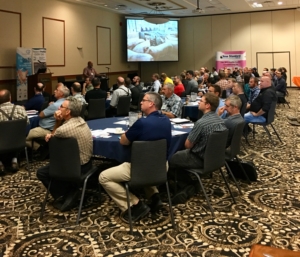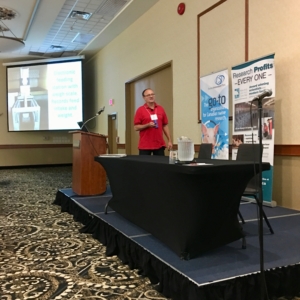An Ontario Pork producer is demonstrating the value of new technology that allows constant monitoring of production.
Innovation and Technology In the Barn were among the topics discussed in Winnipeg, MB as part of a group sow housing seminar hosted by the Prairie Swine Centre, Swine Innovation Porc, and CDPQ. John Van Engelen, with Hog-Tied Farms in Lambton County, Ontario, said the adoption of Wi-Fi technology, which links equipment in the barn to his computer and his cell phone, has allowed constant monitoring. “I have Wi-Fi throughout the barn, and I have a program that goes with my electronic sow feeders, ESF. I can have the program on my phone as I walk through the sows and see how the sows are doing,” said Van Engelen. “If I have a problem with a sow I can get her records up on my phone and access to see what’s going on with that sow or if there’s something wrong with that sow.”

He monitors with RFID technology, the growth rates of the pigs to track the weak ones and the bad ones and pick out the sick ones that way.
“I’m using my sorters as phase feeding so I can feed exactly the feed to the requirement of their weight, so you’re using your sorters all the time instead of just using them when you’re ready to ship pigs,” said the Ontario farmer. “I’m doing dual feed systems in my ESF, so I’m feeding two different feeds to my dry sows. On the third parity plus sows, I’m doing experimenting right now; feeding them lower protein to day 85 and then day 85 they get the upper scale protein. I’m tracking average daily gains with pig performance testers.
Van Engelen has RFID technology on his sorters to track individual animals on the sorters. That’s the technology that makes the operation more efficient to determine where the problem is. He also spoke about what he’s learned about group housing on his pig farm. “It’s a different mentality from stalls to group housing because the social interaction of the animal you have to learn is entirely different,” said the Ontario hog farmer.
“Well, you have to know that when they’re in stalls, there is no social interaction. When they’re in groups, they get to their natural habitat, like social interaction and hierarchy to see who the dominant one is, and who gets to control the place.” When Van Engelen decided to make the change, it appeared it was all or nothing meaning, while a real big change, his determination to see it through is evident today. “And you have to take your time, and be patient, because that’s the biggest thing when dealing with something different, and you don’t know what’s going to be going on, or how the interaction is going to be, you must be patient. He said it is most important first to observe the animals and know how they’re going to react, as far as social interaction between the animals themselves. While not sure if it has increased production it certainly has hurt.
“I can’t say as I’ve gotten that much better, but as far as overall health of the sows and feet and legs, that has been a better improvement. And you can feed more precision feeding, as far as the days, as far as when they’re pregnant; you can feed them different rations and stuff like that. So you’re more or less feeding individuals during their stage of pregnancy to their requirements, which you actually couldn’t even, do in a dry sow stall before. So, you’re doing a better job,” he said. There are still many producers who need some reassurance to make this big move, and he recommends before making any decision to talk to people that are doing it.
“Look around and see the places that are doing it, what their interaction is, and how successful it worked for them,” said Van Engelen. “I went to Europe and toured some operations because they were more advanced and had the code before we did, and so that’s where I got some of my knowledge. But talk to the producers that have the units.” Van Engelen runs about a 240 sow farrow-to-finish operation all under one roof and never borrows a truck to move pigs down the road.
“My production is around 27 pigs per sow per year, and for me, I’m not worried about pigs per sow per year. For me, it’s more meat per ton of feed, and that’s more of an actual evaluation than how many pigs you eat because that tells you how efficient you are feeding, and how much feed it takes to put the pigs to market. So, if I can get more, like around 300 kilos, I’m just around that 300 kilos of sellable meat per ton of feed, that’s a real goal,” he said. •
— By Harry Siemens





